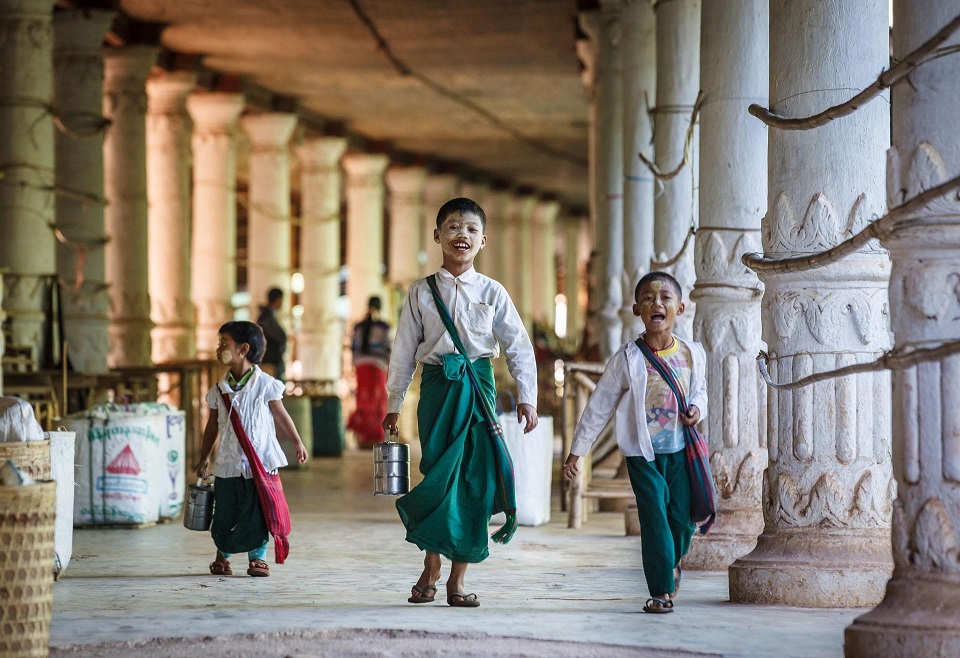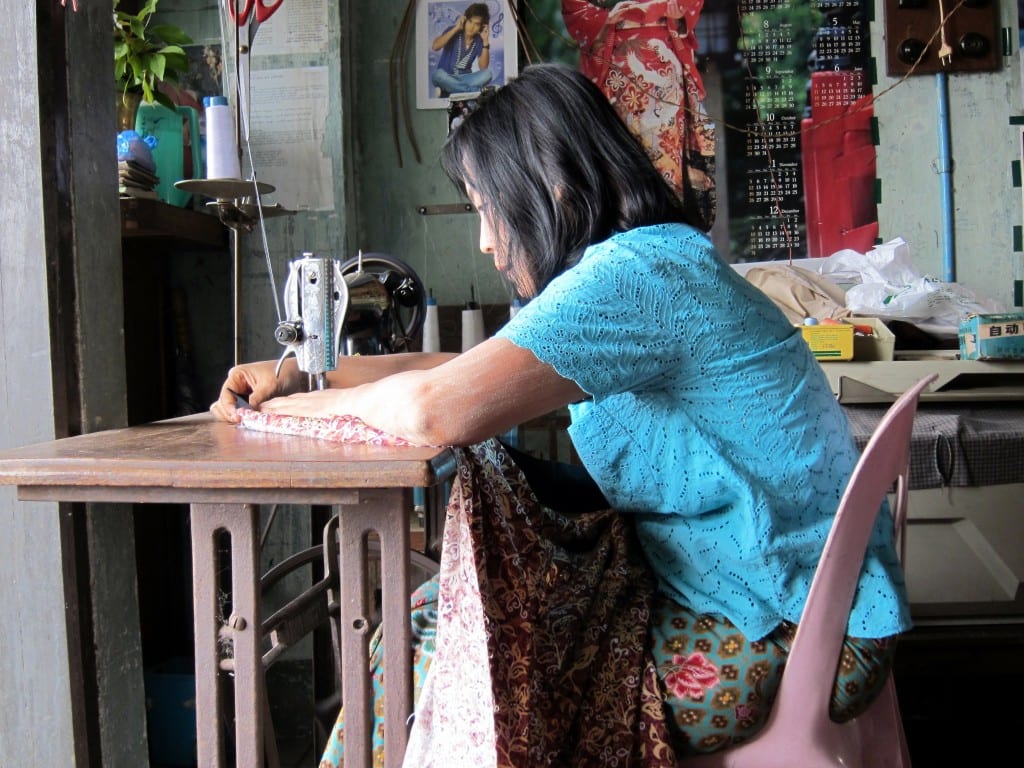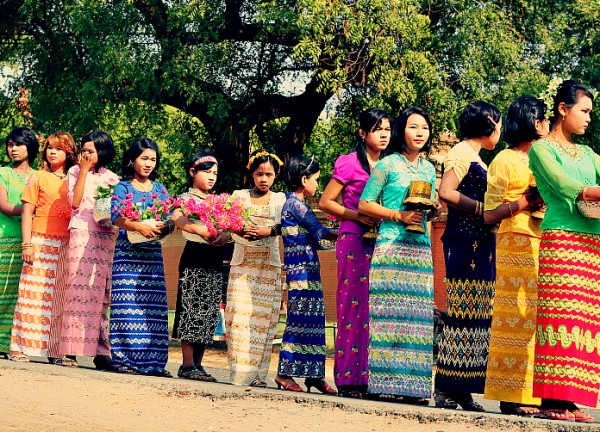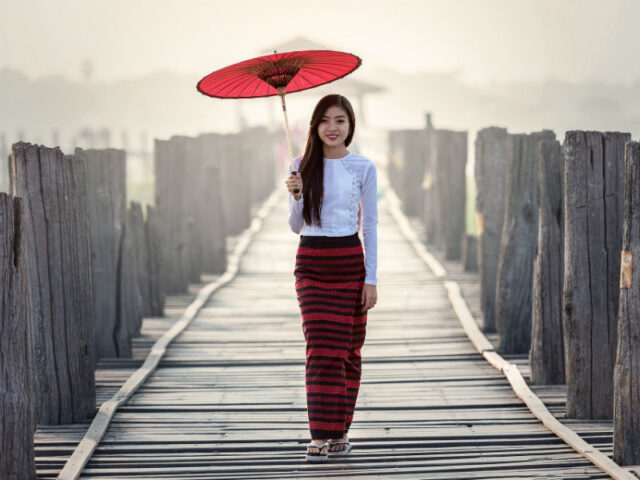I’ve been traveling for as long as I can remember, and I definitely love it. I’ve gone many places throughout my life, but my most recent travels have been spent in and around Asia. I’ve discovered that there is something unique about the culture in Asia. Many of their customs and traditions are intriguing and often unknown.
As a Burmese who grew up and lived in Thailand for four years, I have a lot of appreciation for the culture, the food, and the people. These days, I readily admit that I am very partial to the Burmese language and to the “longyi”, a traditionally hand-woven wrap that is a traditional part of the Burmese wardrobe. I have taken to wearing this wrap in the cooler months, when I’m cooped up in an office or just want to be comfortable on the road.
I have a thing for the color turquoise. It is a color that I believe is underrated, but I never tire of finding new shades, from sea to sky. When I had to pack my bags quickly before an upcoming trip to Myanmar I knew I wanted to keep them as light as possible, and I thought that a Burmese longyi would be a great way to do that.

When I traveled to Burma, I left my laptop in Thailand. I was informed that WiFi would be scarce, and without mobile phone coverage, I was looking forward to reverting to my Moleskine rather than a keyboard. My excitement is apparent when I look back at my journal months later. “Burma is one of those wonderful, apparently utopian locations where you are free to assume the best in the people you meet,” says the second day. It’s strange to juxtapose this warmth with the reality about what’s going on inside military-ruled Burma; you only see what you’re permitted to see. But what you’re seeing is genuine, and in my little time in Burma, magical.” Other tourists encouraged me to come because of the Burmese’s warmth and charity. On the second day, I decided to look for a Burmese longyi, which proved to be the greatest ice breaker I could have hoped for.
The longyi may be found all throughout Burma

A sarong-like tube of fabric worn by both genders, they are called paso when worn by men and htamein by women. Throughout my time in the country everyone merely referred to the gender-neutral term “longyi”. The patterns differ by gender as well: for men, a thin plaid or woven stripe, tied by pulling the fabric tight against the back and tying an elegant knot in front. For women, anything goes: beautiful, bright batik patterns, traditional woven zigazags called acheiq, stripes or flowers. Women tie the longyi by pulling all of the fabric to one side, folding back at the hip and tucking into the opposite side of the waist, usually topped with a fitted blouse worn just to the waistband. The women also sew in a thin band of black fabric at the waist of the longyi. I was told this was “for the sweat”, but I found it handy to figure out which side was up.
On Inle Lake, my host gave alms to the monks in a traditional Shan longyi.
When I discovered how common they were, I decided to buy one. Almost everyone wears the long traditional skirt, and as a single traveler, I felt it would help me fit in. On my second day out of the hostel, I pulled out a map to find out where the market was. Shadows spread over the map in a matter of seconds, and I glanced up in astonishment to see five ladies standing there with smiling grins. One of them inquired, “How can I assist you?” I stated that I was looking for a longyi and before I knew it, I was holding hands with two of the ladies and walking to the fabric shop. Each had a different opinion about what colors suited me best as they followed me around the shop with bolts of cloth on my shoulders. I eventually settled on an Indonesian batik in a delicate cloth with rich purples that complemented the two shirts I already had.
One of the women in the group turned out to be a tailor, and when she grabbed my hand and brought me to her apartment, she shooed the other ladies away. Her building, which was subsidized by the government and was in bad condition, was located in the back alleys of Yangon. “My walls are collapsing,” she remarked as she took me up eight twisting levels of a decaying stairwell, “but the government doesn’t seem to mind.”
View of Yangon from her apartment’s roof.
Her possessions were strewn over display shelves inside the flat, dividing the bed from the remainder of her cramped studio. She stitched the long piece of cloth into a longyi, attached the black band, and prepared a wonderful meal for me. I slipped Kyat beneath her sewing machine and offered to see her daughter the following day to learn English, despite her adamant refusal to pay.
A shelf of belongings for the family of eight inside her small flat.
In the afternoon light, I’m making my longyi.
Back on the streets of Yangon, I realized I had a little issue: she mistook me for someone much taller than I am. To prevent tripping on the longyi, I had to wrap it just below my bust, which meant it kept untucking as I walked. My first item of business when I arrived in Mandalay the following day was to get the longyi shortened. This proved to be a little more difficult than expected since I didn’t know the Burmese term for tailor and forgot to ask my hotel before I went. I attempted to mimic what I wanted to the individuals I encountered as I walked up 82nd street. “You know….brrrrrrrrrrrrrrrrrrrrrrrrrrrrrrrrrrrr I’d say, pounding my foot and air-sewing for good measure while mimicking the machine’s sound. Blank stares were exchanged until a toothless old guy grabbed my hand and dragged me across the street to a tailor.
In Mandalay, I was sewing the hem of my longyi.

The longyi turned out to be a great buy once it fit. As I went through Mandalay’s streets, people would grin and point at the skirt. My small guesthouse in Hpa-An had a public bathroom, so I used it to shower, wrapping the longyi over my whole body and tucking it just under my armpit as the Burmese do. One day, when I was walking to the shower, the owner saw me. He shouted excitedly, “Just like a Burmese girl, even to shower!” The pleasures of public bathing have recently become much more accessible.
Once again, the longyi proven to be an excellent investment in Kachin state. The Kachin State Fair was an amazing welcome to Myitkyina, with tens of thousands of Kachin from all over the globe, days of music, dancing, costumes, and rice wine. One day, while wearing my longyi, I felt it being undone from the side. When I turned back, I saw a group of Kachin women dressed in traditional clothes laughing uncontrollably because I had knotted it on the wrong side of my body, which they thought was funny. It was an amazing day, complete with a series of group photos, them applying my makeup in the middle of a gravel road, and some mohinga thrown in for good measure.
At the Kachin State Fair, I took a self-portrait with Kachin tribeswomen.
When I went to the local markets in Inle Lake at daybreak, I donned the longyi. The Pa-O tribeswomen who had descended from the Shan foothills to purchase their weekly food would marvel at it, with several approaching to touch the cloth or staring at me openly. A few people praised my Burmese style, while others just pointed from afar, but it served as a great icebreaker as well as a chance to snap photos without being too intrusive.
On Inle Lake, my longyi and I were joined by two gorgeous Pa-O tribeswomen.
On Inle, I also discovered that the concern of “whoops, my longyi came off” is a really genuine one. My longyi got hooked on a protruding nail when leaving a small boat, and let’s just say my boat driver and the passing Pa-O boat now know what a white woman’s rear looks like (dressed in underpants, of course), since the longyi plummeted to the ground quicker than I ever imagined possible. Ladies, two words: safety pin.
This boat is racing away because the phosphorous brightness of my rear has dazzled them.
My trip ended in the Mon State, south of Yangon. While in the tiny town of Hpa-An, I went to a dusty shop next to the village’s central market. There, I found the most beautiful longyi I had seen, a wondrous blend of colours and stripes, woven together on a thicker cotton base. The woman in the store would not sell it to me. “Not Burmese,” she stated, pointing at my face. And then, gesturing dismissively at the one piece of clothing that got me into so many homes in Burma, “you cannot wear traditional longyi. Not selling to you.”
I tried again a few days later, hoping for a new lady at the store, but she set her jaw and shook her head the second she noticed my face. On my final day in Yangon, I returned to Boyoke Aung San market to purchase a longyi for a friend, and I eventually located it among the labyrinth of dark corridors and wooden booths. I was so ecstatic that I hugged the lady who ran the store. She, in turn, was so pleased to see me happy that she invited me to spend the day with her, assisting her in selling to visitors. I was able to interpret for a large group of French tourists who stopped by, giving me another huge embrace.
With the huggable sales woman and her kid at a booth in Boyoke Aung San.
It was the ideal way to depart Burma, and yet another demonstration of her people’s hospitality. When I arrived in the nation, I met many men and women who had also purchased longyis, and we all had an easier time meeting, talking with, and befriending locals. It was the greatest thing I could have done when I arrived, and I would advise anybody planning a trip to do the same.
This lovely longyi was my last buy.
A while back I posted an article about my love for my Burmese longyi, a kind of sarong that you wear as a dress. Since then, I’ve been asked about my Burmese longyi at least a dozen times, from friends and family, from journalists and from people wanting photos of me wearing it. So I thought that I would write a post about it. The Burmese longyi is a great and versatile piece of clothing. It works for a variety of weather conditions, and I’ve used mine to wear as a dress in beautiful Yasothon in northeast Thailand, as a shirt in Chang Mai in the north of Thailand, as a skirt in Siem Reap and as a robe in Chiang Mai.. Read more about longyi brothers and let us know what you think.
Frequently Asked Questions

Why do Burmese wear longyi?
Burmese traditionally wear longyi to cover their legs and feet from the sun.
How do you use Burmese longyi?
Burmese longyi is a traditional garment worn by women in Burma. It is made of silk and is wrapped around the waist, with the front piece hanging down to cover the legs.
What is a Burmese longyi?
A Burmese longyi is a traditional garment worn by women in Burma.




